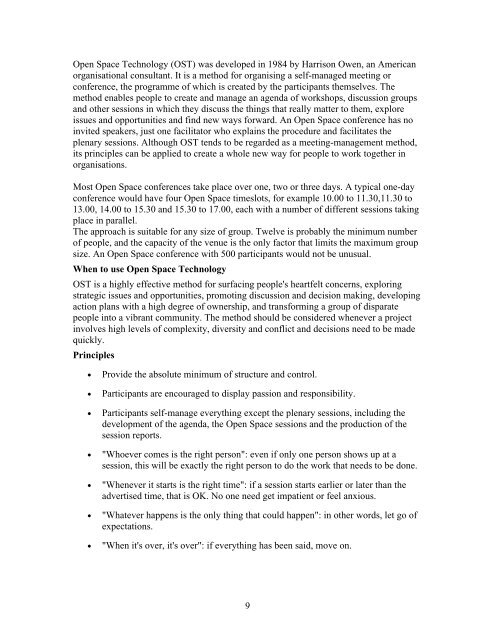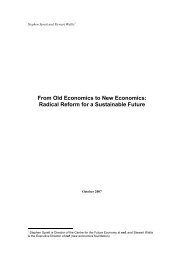Creating the futures we desire - getting the whole ... - Bruce Nixon
Creating the futures we desire - getting the whole ... - Bruce Nixon
Creating the futures we desire - getting the whole ... - Bruce Nixon
Create successful ePaper yourself
Turn your PDF publications into a flip-book with our unique Google optimized e-Paper software.
Open Space Technology (OST) was developed in 1984 by Harrison O<strong>we</strong>n, an American<br />
organisational consultant. It is a method for organising a self-managed meeting or<br />
conference, <strong>the</strong> programme of which is created by <strong>the</strong> participants <strong>the</strong>mselves. The<br />
method enables people to create and manage an agenda of workshops, discussion groups<br />
and o<strong>the</strong>r sessions in which <strong>the</strong>y discuss <strong>the</strong> things that really matter to <strong>the</strong>m, explore<br />
issues and opportunities and find new ways forward. An Open Space conference has no<br />
invited speakers, just one facilitator who explains <strong>the</strong> procedure and facilitates <strong>the</strong><br />
plenary sessions. Although OST tends to be regarded as a meeting-management method,<br />
its principles can be applied to create a <strong>whole</strong> new way for people to work toge<strong>the</strong>r in<br />
organisations.<br />
Most Open Space conferences take place over one, two or three days. A typical one-day<br />
conference would have four Open Space timeslots, for example 10.00 to 11.30,11.30 to<br />
13.00, 14.00 to 15.30 and 15.30 to 17.00, each with a number of different sessions taking<br />
place in parallel.<br />
The approach is suitable for any size of group. T<strong>we</strong>lve is probably <strong>the</strong> minimum number<br />
of people, and <strong>the</strong> capacity of <strong>the</strong> venue is <strong>the</strong> only factor that limits <strong>the</strong> maximum group<br />
size. An Open Space conference with 500 participants would not be unusual.<br />
When to use Open Space Technology<br />
OST is a highly effective method for surfacing people's heartfelt concerns, exploring<br />
strategic issues and opportunities, promoting discussion and decision making, developing<br />
action plans with a high degree of ownership, and transforming a group of disparate<br />
people into a vibrant community. The method should be considered whenever a project<br />
involves high levels of complexity, diversity and conflict and decisions need to be made<br />
quickly.<br />
Principles<br />
• Provide <strong>the</strong> absolute minimum of structure and control.<br />
• Participants are encouraged to display passion and responsibility.<br />
• Participants self-manage everything except <strong>the</strong> plenary sessions, including <strong>the</strong><br />
development of <strong>the</strong> agenda, <strong>the</strong> Open Space sessions and <strong>the</strong> production of <strong>the</strong><br />
session reports.<br />
• "Whoever comes is <strong>the</strong> right person": even if only one person shows up at a<br />
session, this will be exactly <strong>the</strong> right person to do <strong>the</strong> work that needs to be done.<br />
• "Whenever it starts is <strong>the</strong> right time": if a session starts earlier or later than <strong>the</strong><br />
advertised time, that is OK. No one need get impatient or feel anxious.<br />
• "Whatever happens is <strong>the</strong> only thing that could happen": in o<strong>the</strong>r words, let go of<br />
expectations.<br />
• "When it's over, it's over": if everything has been said, move on.<br />
9



